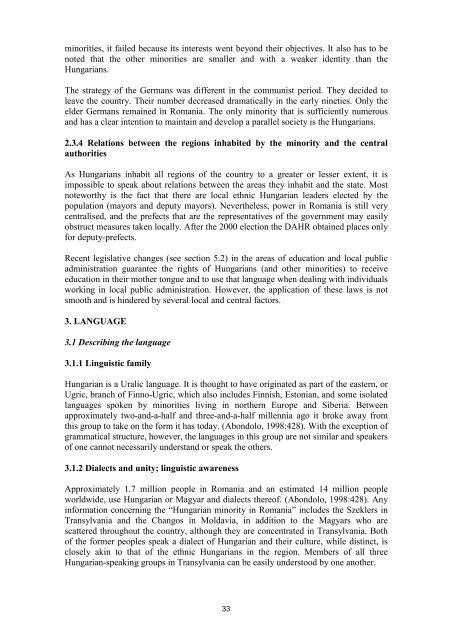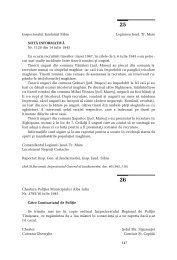Southeast Europe
Southeast Europe
Southeast Europe
You also want an ePaper? Increase the reach of your titles
YUMPU automatically turns print PDFs into web optimized ePapers that Google loves.
minorities, it failed because its interests went beyond their objectives. It also has to be<br />
noted that the other minorities are smaller and with a weaker identity than the<br />
Hungarians.<br />
The strategy of the Germans was different in the communist period. They decided to<br />
leave the country. Their number decreased dramatically in the early nineties. Only the<br />
elder Germans remained in Romania. The only minority that is sufficiently numerous<br />
and has a clear intention to maintain and develop a parallel society is the Hungarians.<br />
2.3.4 Relations between the regions inhabited by the minority and the central<br />
authorities<br />
As Hungarians inhabit all regions of the country to a greater or lesser extent, it is<br />
impossible to speak about relations between the areas they inhabit and the state. Most<br />
noteworthy is the fact that there are local ethnic Hungarian leaders elected by the<br />
population (mayors and deputy mayors). Nevertheless, power in Romania is still very<br />
centralised, and the prefects that are the representatives of the government may easily<br />
obstruct measures taken locally. After the 2000 election the DAHR obtained places only<br />
for deputy-prefects.<br />
Recent legislative changes (see section 5.2) in the areas of education and local public<br />
administration guarantee the rights of Hungarians (and other minorities) to receive<br />
education in their mother tongue and to use that language when dealing with individuals<br />
working in local public administration. However, the application of these laws is not<br />
smooth and is hindered by several local and central factors.<br />
3. LANGUAGE<br />
3.1 Describing the language<br />
3.1.1 Linguistic family<br />
Hungarian is a Uralic language. It is thought to have originated as part of the eastern, or<br />
Ugric, branch of Finno-Ugric, which also includes Finnish, Estonian, and some isolated<br />
languages spoken by minorities living in northern <strong>Europe</strong> and Siberia. Between<br />
approximately two-and-a-half and three-and-a-half millennia ago it broke away from<br />
this group to take on the form it has today. (Abondolo, 1998:428). With the exception of<br />
grammatical structure, however, the languages in this group are not similar and speakers<br />
of one cannot necessarily understand or speak the others.<br />
3.1.2 Dialects and unity; linguistic awareness<br />
Approximately 1.7 million people in Romania and an estimated 14 million people<br />
worldwide, use Hungarian or Magyar and dialects thereof. (Abondolo, 1998:428). Any<br />
information concerning the “Hungarian minority in Romania” includes the Szeklers in<br />
Transylvania and the Changos in Moldavia, in addition to the Magyars who are<br />
scattered throughout the country, although they are concentrated in Transylvania. Both<br />
of the former peoples speak a dialect of Hungarian and their culture, while distinct, is<br />
closely akin to that of the ethnic Hungarians in the region. Members of all three<br />
Hungarian-speaking groups in Transylvania can be easily understood by one another.<br />
33









